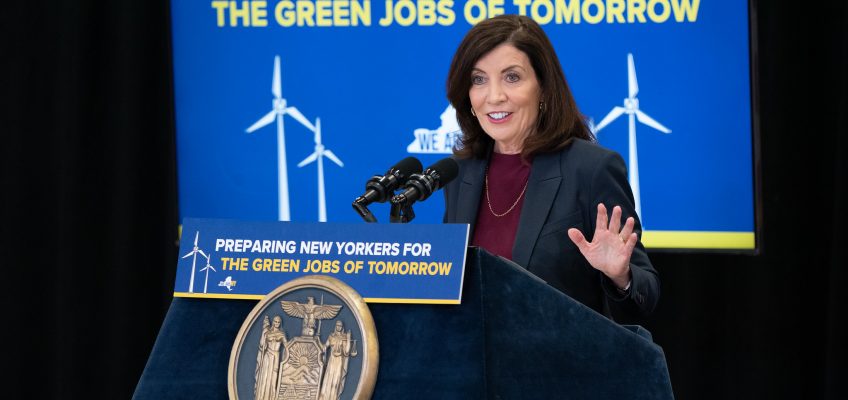“Investing in clean energy, built by skilled, safe union workers, can create the triple win of lower energy costs, good-paying jobs, and stronger communities.”
Gov. Kathy Hochul at a press conference about offshore wind opportunities in 2022. (Flickr/Governor Kathy Hochul)
Extreme heat this summer has caused rolling blackouts across New York City. From Staten Island to Queens, families were not only left sweltering, but also wondering—why? Even though we are the nation’s largest city by population, a world capital, a global leader in so many ways, we continue to rely on an outdated energy grid without enough local power supply.
As conflict entangles the globe, we face the risk of supply interruptions and spiking oil and gas prices here at home. This doesn’t have to be the case, yet we continue to rely on volatile foreign markets for our own energy security.
Big crises are also big opportunities. So amid all of this political uncertainty, it’s worth imagining what it would look like to achieve real stability and independence for our energy system—a grid with abundant and reliable power that doesn’t pollute our neighborhoods or fail to meet demand on the hottest day of the year; an energy supply free from the volatility and uncertainty of foreign sources; and an energy industry that creates good union jobs for working people, so that more Americans can live with dignity and prosperity.
The good news is that I see this vision coming into reality here in New York. I proudly represent more than 45,000 union brothers and sisters in the Laborers’ Eastern Region. These are the skilled workers who are building clean energy projects—from wind turbines to solar panels and soon, the nation’s first new nuclear generation facility in over 15 years. By building this critical infrastructure with union labor, New York is taking an “all of the above” path towards a clean energy transition and making sure our energy future benefits workers in our state.
That is the good news, but the scary news is that just as energy demand is rising, federal lawmakers have decided to slam the brakes on domestic energy development.
Congress passed, and President Donald Trump signed into law, a budget reconciliation bill that abruptly ends clean energy tax credits. It’s a policy decision that is poised to kill thousands of jobs, stop new domestic energy projects in their tracks, and raise household electricity costs in New York by over $470 a year for the average household.
Higher prices, fewer jobs, and less homegrown energy spells the exact opposite of energy independence, but that’s just what the Republican-led leadership in Washington, DC has done.
Now, it is up to states like ours to step up and lead the way to an energy-independent future that provides New Yorkers with affordable, reliable power and creates family-supporting union jobs. We must use state policy and funding to fill the gaps this federal budget has left.
New York State must continue to pursue our ambitious clean energy and emissions reduction targets. We must authorize and support new clean energy projects, built with strong labor standards that ensure quality construction and protect workers.
I know these are divisive times, but don’t we all want affordable and reliable energy powered by hard-working Americans? Can we not agree that we should end power outages and spiking energy bills?
Union workers know the answers to these questions. It’s why our training programs offer classes in solar, wind, and geothermal technologies—the energy sources of the future. It’s also why we’re proud to be building ports like Arthur Kill Terminal in Staten Island and South Brooklyn Marine Terminal to support local offshore wind projects.
In densely populated downstate areas without much open land to build on, we understand the need to harness the abundant winds blowing across our oceans to deliver clean power to our grid. Clean energy technologies are the quickest energy source to deploy domestically.
New York must keep building homegrown clean energy because it’s the only way to achieve true energy independence. Yes, the federal government has just made it harder to invest in greener, more reliable energy, but New York was a clean energy leader before these federal tax credits were enacted, and we can continue to be one after they are eliminated.
In New York, we’re all too familiar with heat-induced blackouts and energy bills that make your eyes pop. But it doesn’t have to be this way. Investing in clean energy, built by skilled, safe union workers, can create the triple win of lower energy costs, good-paying jobs, and stronger communities. It can free us of this status quo and bring us into a better future—a future of energy independence. New York State must take up the mantle of leadership to make it happen.
Mike Hellstrom serves as vice president and eastern regional manager of the Laborers’ International Union of North America (LIUNA) serving New York City, Long Island, New Jersey, Delaware, and Puerto Rico.
The post Opinion: New York Must Step Up As a Clean Energy Leader in the Face of Federal Cuts appeared first on City Limits.




